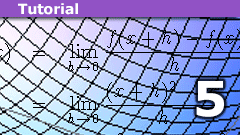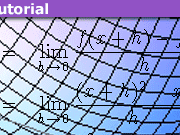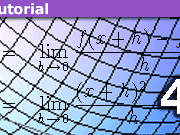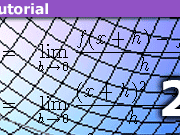The Pantheon of Derivatives – Part V
Click for complete series
Table of Contents
Important Theorems – biased, of course
Implicit Function Theorem [1]
Jacobi Matrix (Chain Rule).
Let ## (x_0,y_0 ) ## be a point in
$$U_1 \times U_2 = \{x \in \mathbb{R}^k\,\vert \,||x-x_0||< \varepsilon_1 \} \times \{y \in \mathbb{R}^m\,\vert \,||y-y_0||< \varepsilon_2\}$$
and ## f: U_1 \times U_2 \rightarrow \mathbb{R}^m ## a function with ##f(x_0,y_0)=0## which is totally differentiable at ##(x_0,y_0)## such that the ##(m \times m)-##matrix ##\frac{\partial f}{\partial y} (x_0,y_0)## is invertible.
In addition let ##g: U_1 \rightarrow \mathbb{R}^m## be a continuous function with ##g(x_0)=y_0## and ##g(U_1) \subseteq U_2## and ##f(x,g(x))=0## for all ##x \in U_1##
Then ##g## is differentiable at ##x_0## and for the Jacobi matrices
\begin{equation}\label{Jacobi-Matrix}
\frac{\partial g}{\partial x} = \left(\frac{\partial g_i}{\partial x_j}\right)_{{1 \leq i \leq m} \atop {1 \leq j \leq k}}\, , \,\frac{\partial f}{\partial x} = \left(\frac{\partial f_i}{\partial x_j}\right)_{{1 \leq i \leq m} \atop {1 \leq j \leq k}}\, , \,\frac{\partial f}{\partial y} = \left(\frac{\partial f_i}{\partial y_j}\right)_{{1 \leq i \leq m}\atop {1 \leq j \leq m}}
\end{equation}
the following equation holds:
\begin{equation}\label{Kettenregel}\begin{aligned}
\frac{\partial g}{\partial x}(x_0)&=-\left[\frac{\partial f}{\partial y}(x_0,y_0)\right]^{-1} \cdot \frac{\partial f}{\partial x}(x_0,y_0) \\ 0 &= \frac{\partial f}{\partial x}(x_0,y_0)\, +\, \frac{\partial f}{\partial y}(x_0,y_0) \cdot \frac{\partial g}{\partial x}(x_0)
\end{aligned}\end{equation}
Implicit Function.
Let ##f : U_1 \times U_2 \rightarrow \mathbb{R}^m## be continuous differentiable on open sets ##U_1 \subseteq \mathbb{R}^k\, , \,U_2 \subseteq \mathbb{R}^m##, i.e. ##f\in C^1(U_1 \times U_2)##, and ##f(x_0,y_0)=0## such that the ##(m \times m)-##matrix ##\frac{\partial f}{\partial y}(x_0,y_0)## is invertible.
Then there are open neighborhoods ##V_i \subseteq U_i## of ##(x_0,y_0)## and a continuous function ##g : V_1 \rightarrow V_2##, i.e. ##g\in C^0(V_1 \times V_2)##, such that ##f(x,g(x))=0## for all ##x \in V_1##. For a point ##(x,y)\in V_1 \times V_2## with ##f(x,y)=0##, it follows that ##y=g(x)##.
Cauchy’s Integral Formula [2]
Let ##f: U \rightarrow \mathbb{C}## be a holomorphic function on the open set ##U## and ##A \subseteq U## compact with a smooth boundary and ##z_0## a inner point of ##A##. Then
\begin{equation}\label{CauchyIntegralFormel}
f(z_0)= \frac{1}{2\pi i}\,\int_{\partial A} \frac{f(z)}{z-z_0}\,dz
\end{equation}
Cauchy-Goursat Theorem [2],[20],[22]
Simply Connected Domain.
Let ##U## be a simply connected domain, e.g. a star domain, where each holomorphic function has an anti-derivative. Then
\begin{equation}\label{Cauchy-Goursat-I}
\oint_\Gamma f(z)\,dz =0
\end{equation}
for all closed paths ##\Gamma : [0,1] \rightarrow U##.
Homotopy Version.
If ##U \subseteq \mathbb{C}## is an open set and ##\gamma \sim \eta : [0,1]\rightarrow U## two homotopic paths, then
\begin{equation}\label{Cauchy-Goursat-II}
\int_\gamma f(z)\,dz = \int_\eta f(z)\,dz
\end{equation}
Homology Version.
For a (open and connected) domain ##U\subseteq \mathbb{C}## and a closed path ##\Gamma ## in ##U##
\begin{equation}\label{Cauchy-Goursat-III}
\int_\Gamma f(z)\,dz = 0 \textrm{ for holomorphic functions } f \Longleftrightarrow \Gamma \textrm{ is homologous to zero in }U
\end{equation}
Isolated Singularities.
For a (non-empty, open, connected) domain ##U\subseteq \mathbb{C}##, an inner point ##z_0 \in U##, a holomorphic function ##f: U\backslash \{z_0\} \rightarrow \mathbb{C}## and a closed path ##\Gamma## which surrounds positively oriented the isolated point ##\{z_0\} \; \operatorname{ind}_\Gamma (z_0)-##times in ##U##, there is an open punctured disc ##U_\varepsilon \backslash \{z_0\} \subseteq U##, which is relatively compact in ##U##, and ##f|_{U_\varepsilon}## is holomorphic, such that
\begin{equation}\label{Singularities}
\oint_\Gamma f(z)\, dz = \operatorname{ind}_\Gamma (z_0) \cdot \oint_{\partial U_\varepsilon} f(z) \, dz
\end{equation}
##\operatorname{ind}_\Gamma (z_0)## is called the winding number of ##\Gamma##. With the definition of residues, i.e.
\begin{equation}\label{Residues}
\operatorname{res}_{z_0} (f) := \frac{1}{2 \pi i} \, \oint_{\partial U_\varepsilon} f(z) \, dz
\end{equation}
this gets
\begin{equation}\label{Windings}
\frac{1}{2 \pi i} \, \oint_\Gamma f(z)\, dz = \operatorname{ind}_\Gamma (z_0) \cdot \operatorname{res}_{z_0} (f)
\end{equation}
(Cauchy’s) Residue Theorem [2],[21],[22]
Let ##U \subseteq \mathbb{C}## be a non-empty, simply connected, open domain and ##U_d \subseteq U## a discrete set, i.e. a set of isolated points. For a holomorphic function ##f: U \backslash U_d \rightarrow \mathbb{C}## and a closed path ##\Gamma : I \rightarrow U \backslash U_d##, where ##I \subseteq \mathbb{R}## is a closed real interval, then
\begin{equation}\label{CauchyResidueTheorem}
\frac{1}{2\pi i} \cdot \int _{\Gamma}f(z)\, dz =\sum_{z_0 \in U_d}\operatorname{ind}_{\Gamma}(z_0) \cdot \operatorname{res}_{z_0}(f)
\end{equation}
Liouville’s Theorem [24],[25]
Let ##f: \mathbb{C} \rightarrow \mathbb{C}## a bounded entire function, i.e. ##f## is holomorphic on the entire complex plane and there is a constant ##C \in \mathbb{R}## such that ##||f(z)|| < C## for all points ##z \in \mathbb{C}##, then ##f## is constant.
Riemann’s Removable Singularity Theorem [26]
Let ##U## be a non-empty, open, connected domain, ##z_0 \in U## and ##f: U \backslash \{z_0\} \rightarrow \mathbb{C}## a holomorphic function. If there is a punctured neighborhood ##U_0## of ##\{z_0\}##, i.e. ##z_0## is a inner point of the closure of ##U_0## but isn’t an element of ##U_0##, such that ##||f(z)||< C## for a constant ##C \in \mathbb{R}## and all points ##z \in U_0##, then there is a holomorphic function ##\overline{f}: U \rightarrow \mathbb{C}## that extends ##f## on the entire ##U##, i.e. ##\overline{f}|_{U\backslash \{z_0\}} = f##.
In this case ##z_0## is called a removable singularity of ##f##.
Singularities in general of a function ##f## are points, at which ##f## isn’t defined.
A singularity ##z_0## is called a pole of ##f## if it isn’t a removable singularity, but there is a natural number ##k \in \mathbb{N}## such that ##(z-z_0)^k \cdot f(z)## is a removable singularity at ##z_0##. The minimal number ##k## is then called the order of the pole ##z_0##.
Singularities that are neither removable nor poles are called essential singularities.
Little Picard’s Theorem [27]
The image ##\operatorname{img}(f) = \{f(z)\,\vert \,z \in \mathbb{C}\}## of a non-constant entire function ##f## is the entire complex plane without at most one point, i.e. ##\operatorname{img}(f) = \mathbb{C}## or ##\operatorname{img}(f) = \mathbb{C}\backslash \{z_0\}## with a single point ##z_0 \in \mathbb{C}##.
Great Picard’s Theorem [28]
Let ##f## be a holomorphic function with an essential singularity at a point ##z_0##, then on any punctured neighborhood of ##z_0##, ##f(z)## takes on all possible complex values, with at most a single exception, infinitely often.
Picard-Lindelöf Theorem [29]
Local Version.
Let ##N## be a Banach space and ##[a,b] \times \overline{B}_{y_0}(r) \subseteq C \subseteq \mathbb{R}\times N## on which a function
\begin{equation}\label{PLT-I}
f(x,y): C \longrightarrow N
\end{equation}
is defined, that is continuous in the first real variable ##x## and locally Lipschitz continuous in the second. ##\overline{B}_{y_0}(r) \subseteq M## is the closed ball with radius ##r## and center ##y_0 \in N##. Then there is exactly one solution to the initial value problem
\begin{equation}\label{PLT-II}
\begin{aligned}
y’ &= f(x,y)\\
y(a)&= y_0
\end{aligned}
\end{equation}
on the intervall ##[a,a+\eta]## with values in ##\overline{B}_{y_0}(r)## where ##\eta = \min \{b-a,\frac{r}{r_0}\}## and ##r_0 = \max \{\, ||f(x,y)||\, \,\vert \, (x,y)\in [a,b] \times \overline{B}_{y_0}(r)\}##.
Global Version.
Let ##N## be a Banach space and ##f: [a,b] \times N \longrightarrow N## a continuous function, which is Lipschitz continuous in the second variable. Then for every ##y_0 \in N## there is a unique global solution ##y: [a,b] \rightarrow N## (without any further local solutions) to the initial value problem
\begin{equation}\label{PLT-III}
\begin{aligned}
y’ &= f(x,y)\\
y(a)&= y_0
\end{aligned}
\end{equation}
Stokes Theorem [2],[5]
Let ##M## be a orientable, compact smooth manifold with a piecewise smooth boundary ##\partial M## and ##\omega \in \Gamma(\wedge^{n-1}M)## a smooth alternating differential form (exterior derivative) of grade ##n-1##. Then
\begin{equation}\label{key}
\int_{M} d\omega =\int_{\partial M}\omega
\end{equation}
Gauß Theorem – Divergence Theorem [2],[5]
Let ##V \subseteq \mathbb{R}^n## be a compact volume with a piecewise smooth boundary ##\partial V## and ##F## a smooth vector field defined in an open neighborhood of ##V## and ##N## its unit normal field, then
\begin{equation}\label{GT}
\iiint_{V} \left( \nabla \cdot F\right)\,dV = \iint _{\partial V} (F \cdot N)\,d(\partial V)
\end{equation}
Frobenius Theorem [5]
A subbundle ##F## of a tangent bundle ##TM## of a smooth manifold ##M## is integrable if and only if the vector fields with values in ##F## build a Lie subalgebra of the Lie algebra of ##TM##.
Hairy Ball Theorem [4]
On a sphere ##S^n## exists a continuous tangent vector field which is nowhere zero, if and only if ##n## is odd.
Noether’s Theorem [5],[9]
I will quote the two versions in Olver’s book [5] without any explanations since these would lead too far. For those who are interested in the original publications by Emmy Noether, I have linked the websites where they can be found, see [9].
Common Version
Suppose ##G## is a (local) one-parameter group of symmetries of the variational problem ##\mathcal{L}[u]=\int L(x,u^{(n)})\, dx##. Let
\begin{equation}\label{EMT-I}
v=\sum_{i=1}^{p}\xi^i(x,u)\frac{\partial}{\partial x^i}+\sum_{\alpha = 1}^{q} \varPhi_\alpha (x,u) \frac{\partial}{\partial u^{\alpha}}
\end{equation}
be the infinitesimal generator of ##G##, and
\begin{equation}\label{EMT-II}
Q_\alpha (x,u)= \varPhi_\alpha – \sum_{i=1}^{p} \xi^i u_i^{\alpha}\; ,\quad u_i^{\alpha} = \frac{\partial u^{\alpha}}{\partial x^i}\,,
\end{equation}
the corresponding characteristic of ##v##. Then ##Q=(Q_1,\ldots ,Q_q)## is also a characteristic of a conservation law for the Euler-Lagrange equations ##E(L)=0##; in other words, there is a ##p-##tuple ##P(x,u^{n})=(P_1,\ldots ,P_p)## such that
\begin{equation}\label{EMT-III}
\operatorname{Div} P = Q \cdot E(L) = \sum_{\nu = 1}^{q} Q_\nu E_\nu L
\end{equation}
is a conservation law in characteristic form for the Euler-Lagrange equations ##E(L)=0##.
General Version
A generalized vector field ##v## determines a variational symmetry group of the functional ##\mathcal{L}[u]= \int L\,dx## if and only if its characteristic ##Q\in \mathcal{A}^q## is the characteristic of a conservation law ##\operatorname{Div} P =0## for the corresponding Euler-Lagrange equations ##E(L)=0##. In particular, if ##\mathcal{L}## is a nondegenerate variational problem, there is a one-to-one correspondence between equivalence classes of nontrivial conservation laws of the Euler-Lagrange equations and equivalence classes of variational symmetries of the functional.
Epilog
In retrospect, I might have chosen Stokes’ theorem as a central concept or simply Leibniz’s product rule, as they somehow connect everything in this essay and can be compared with Paris in the French railway metric. Unfortunately one has to have already all concepts and definitions at hand for such an undertaking. This has been the reason to write this essay: to provide a place where the world of derivatives comes together in one place, a quick reference guide if you like. As I began to write it, I didn’t imagine it would take so many pages, although there could be and have been written entire textbooks on each of the sections or even subsections above. For detailed studies, I have to refer to them as I for sure have missed some aspects others might consider essential.
In the end, the question of how all these abstract analytic, algebraic, and topological concepts relate to actual calculations and physics is not a matter of tools or obviousness, it is a matter of abstraction and the decision of how far one wants to go on the venture to explore the beauty of nature.
Sources
Sources
- https://www.amazon.com/Analysis-Differentialrechnung-gewöhnliche-Differentialgleichungen-Mathematik/dp/3658023562
- https://www.amazon.com/Analysis-Integrationstheorie-Integralsätze-Anwendungen-Aufbaukurs/dp/3658167459
- https://www.amazon.com/Elementary-Differential-Geometry-Undergraduate-Mathematics/dp/0387903577
- https://www.amazon.com/Alternierende-Differentialformen-German-Holmann/dp/3860258613
- https://www.amazon.com/Applications-Differential-Equations-Graduate-Mathematics/dp/0387950001
- https://www.amazon.com/Lie-Groups-Algebras-Cohomology-MN-34/dp/069108498X/
- https://www.amazon.com/Groups-Algebras-Representation-Graduate-Mathematics/dp/0387909699/
- Jean Dieudonné, Geschichte der Mathematik 1700-1900, Vieweg Verlag 1985
- http://gdz.sub.uni-goettingen.de/en/dms/loader/img/?PID=GDZPPN002504979
- http://www.math.nyu.edu/faculty/childres/fluidsbook.pdf
- http://www.chem.mtu.edu/~fmorriso/cm4650/2012SubstantialDerivative.pdf
- http://www.math.ttu.edu/~klong/5311-spr09/diff.pdf
- https://www.mathematik.uni-marburg.de/~eckert/scripts/diffgeometrie.pdf
- http://mitschriebwiki.nomeata.de/RieGeo.pdf.5.pdf
- https://www.physicsforums.com/threads/why-the-terms-exterior-closed-exact.871875/#post-5474443
- https://ncatlab.org/nlab/show/HomePage
- https://de.wikipedia.org/wiki/Wikipedia:Hauptseite
- https://en.wikipedia.org/wiki/Main_Page
- https://fr.wikipedia.org/wiki/Wikipédia:Accueil_principal
- http://web.math.ucsb.edu/~helena/teaching/math122b/cauchygoursat.pdf
- https://homepage.tudelft.nl/11r49/documents/wi4006/cauchy.pdf
- http://www.math.harvard.edu/~knill/teaching/residues_1996/residue.pdf
- https://www.math.ust.hk/~maykwok/courses/ma304/06_07/Complex_6.pdf
- https://www.math.uni-hamburg.de/home/latschev/lehre/ws13/funk/5_Liouville.pdf
- http://acc.physik.uni-frankfurt.de/vorlesung/WS1011/hl_liouville.pdf
- https://www.math.uci.edu/~brusso/220C040908.pdf
- https://www.math.uh.edu/~minru/6322-11/picard.pdf
- https://projecteuclid.org/download/pdf_1/euclid.bbms/1086969317
- https://embedded.eecs.berkeley.edu/eecsx44/lectures/Spring2013/Picard.pdf
The Pantheon of Derivatives FULL PDF







What an incredible resource! Thank you Fresh!
1) regarding the Implicit Function Theorem:
there is no need to demand ##f## to be totally differentiable in ##(x,y)## Actually ##f## must be differentiable just in the second argument while the first one can belong to a topological space. By the way, ##mathbb{R}^m## can also be replaced with a Banach space.
2) Formula (15) holds for any Riemann manifold and follows from (14) with the help of results from previous part.
I think that theCauchy-Goursat Theorem can also be obtained from the Stokes formula without a considerable loss of generality.